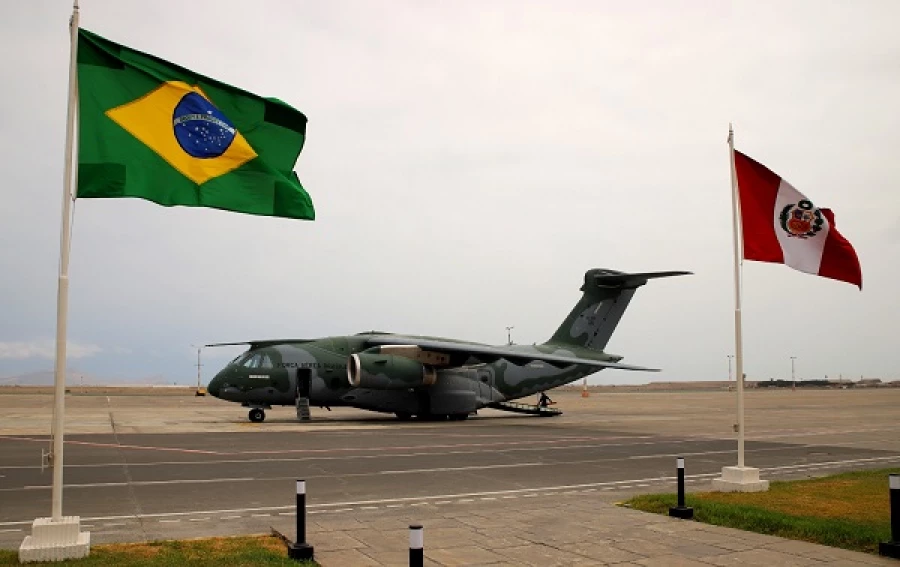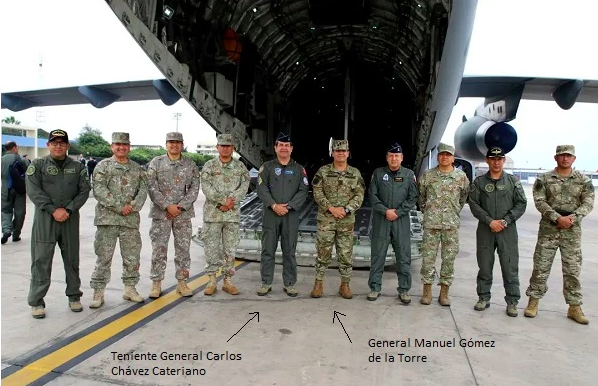BY Peter Watson
Members of the Peruvian military high command have had the opportunity to carry out a demonstration flight along with the Brazilian crew of a KC-390 military transport aircraft and an aerial tanker of the Brazilian Air Force in the context of the multinational combined exercise Cooperation IX that took place in Peru between May 8 and 18.
More than 20 aircraft from 12 countries participated.
Both the head of the Joint Command of the Peruvian Armed Forces, General Manuel Gómez de la Torre Araníbar, and Lieutenant General Carlos Enrique Chávez Cateriano, Chief of the General Staff of the Peruvian Air Force (FAP), was able to appreciate the flight qualities of the twin-engine multirole transport aircraft produced by Embraer as a direct competitor of the legendary C-130 Hercules of the US Lockheed Martin.

Peru’s three armed forces personnel accompanied the senior military officers.
The demonstration flight took place on May 16 at the FAP Air Group No. 8 facilities in Callao, two days before the start of the Sitdef fair.
INVENTORY
The Peruvian Air Force lines up a pair of L-100-20 Hercules and two KC-130H Hercules air transport aircraft acquired from the Spanish Ministry of Defense as a surplus of its Air Force.
It also has four twin-engine C-27J Spartan medium military transport aircraft produced by the Italian Leonardo Company, which in addition to being characterized by their robustness, have the same engines used by the C-130J / KC-130J Hercules, with which it was expected to obtain greater communication if the plans of the armed institute to acquire six of these aircraft were carried out, based on the experience accumulated for some 50 years with aircraft of the Hercules family.
The FAP also plans to acquire more of the Spartan, awaiting the next authorization to purchase two more units.
Unlike the four turboprop engines of the latest Hercules variant, the KC-390 integrates two powerful turbofan engines as propulsion.
Each of these two engine types has comparative advantages over the other, and their choice depends primarily on the role in which the aircraft integrating them will be used most frequently, including unforeseen contingencies.
On the other hand, it is difficult to compete with the availability of parts and components for the Hercules, an aircraft that has users on every continent.
The same can be said of the proven longevity of the US-made aircraft.
The KC-390 has a wingspan of 35.05 meters, a length of 35.20 meters, a height of 11.84 meters, a maximum takeoff weight of 87 metric tons, a maximum speed of Mach 0.8 (988 km/h), a maximum range of 6,000 kilometers.
It can take off on 1,130 meters of a runway in tactical configuration.
Its cargo compartment is 18.5 meters long, 3.45 meters wide, and 2.95 meters high, a space the Brazilian Air Force highlights as sufficient to accommodate armored vehicles.
The KC-390 can also carry on board up to 80 military personnel with their equipment, 64 paratroopers or 74 stretchers in aeromedical evacuation configuration, and integrates into the nose a modern Gabbiano T20 tactical radar that can track up to 200 targets simultaneously, radar that has Spot SAR functionality, weather mode or air-to-air mode, in addition to a state-of-the-art digital cockpit developed by Rockwell Collins.
Apart from speed, the parameter in which the KC-390 excels is the payload. It can carry up to 23 metric tons of distributed cargo and 26 metric tons of concentrated cargo.

With information from Infodefensa
News Peru, English News Peru, Peruvian military

